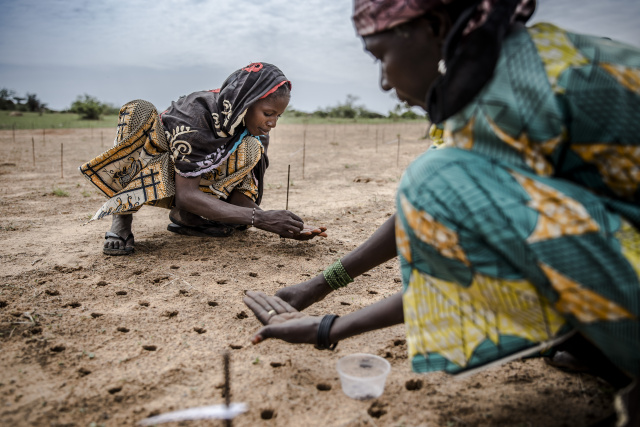Africa sees 'most challenging' environment in years: IMF

(FILES) In this file photo taken on July 30, 2019 A woman plants some seeds as part of a tree plantation project to reforest the Sahel in Malamawa village, Zinder Region, Niger on July 30, 2019. In the African Sahel, located between the Sahara Desert and the equator, the climate has long been inhospitable. But now rising temperatures have caused prolonged drought and unpredictable weather patterns, exacerbating food shortages, prompting migration and contributing to instability in countries already beset by crisis. With a modest USD 13 million purse, Denmark has become the first nation to allocate aid for climate change-related "loss and damages" for the world's most vulnerable countries. As climate change quantifiably amplifies the devastation of extreme weather events such as the recent hurricane-fuelled storm surges in Florida and the record floods in Pakistan this summer, pressure is mounting on developed nations to help poorer ones cope. (Photo by Luis TATO / FAO / AFP)
(AFP) - Sub-Saharan Africa faces its "most challenging environment in years," with the region's pandemic recovery disrupted by surging inflation, rising interest rates and a global slowdown, the IMF said Friday.
The crisis lender's assessment came days after it downgraded the region's growth prospect to 3.6 percent for 2022 -- markedly lower than last year's 4.7 percent figure -- as rising food and energy costs hit vulnerable groups while public debt ballooned.
"The region's prospects are tied firmly to developments in the global economy," the IMF said in a regional economic outlook report, adding that many countries continue to face tough socio-political and security situations.
The world has been hit by multiple shocks, with countries spending heavily to protect their economies during the coronavirus pandemic before facing supply chain snarls as they emerged from lockdowns.
Prices soared further after Russia's invasion of Ukraine, prompting central banks to raise interest rates aggressively.
Food and fuel prices have raised the cost of living, inflicting particular pain on sub-Saharan Africa given that a high share of income in the region goes towards food, the IMF's African department chief, Abebe Aemro Selassie, told AFP.
"This has been a big source of dislocation, an extremely harmful period for the poorest and most vulnerable people and countries," he said.
There are 123 million people facing acute food insecurity in the region, the IMF report said, stressing the need to ensure that scarce resources go to the most needy.
The fund also called for better implementation of the G20 "common framework" for debt restructuring, and cautioned that debt levels have grown but rising global interest rates mean funding access will "likely become much less forgiving."
And as the region endures its third year of crisis, policymakers have limited space to confront the latest challenges.
Fiscal positions have worsened during the pandemic and regional public debt climbed to about 60 percent of GDP, said the IMF.
Meanwhile, about 40 percent of the region's economies now see double-digit inflation, the report added.
"We risk... countries devoting from the limited resources they have, more and more of that share addressing unsustainable debt," said Selassie.
But he cautioned that institutions like the IMF and World Bank cannot support countries when their debt is unsustainable, given that resources provided "would go towards addressing the debt rather than creating fiscal space."
"This is why speed is of the essence, to make sure that there is an orderly process... so we can come in and provide financing," Selassie said.
Sub-Saharan Africa accounts for 60 percent of all people in extreme poverty, the World Bank said last week, adding that history-defying growth rates would be needed for the rest of the decade to hit poverty-reduction targets.
© Agence France-Presse





